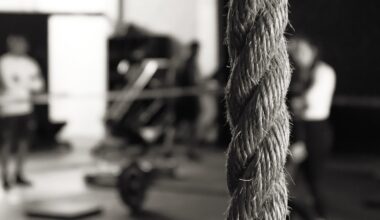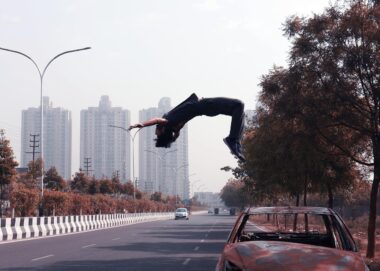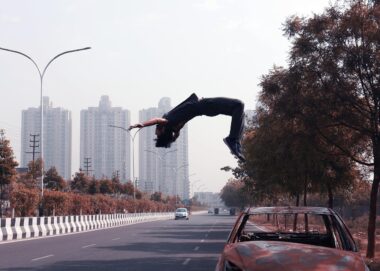Choosing Parkour Shoes for Different Skill Levels
When selecting shoes for parkour, recognizing your skill level is vital. Beginners should prioritize comfort and cushioning. This foundational stage in parkour requires shoes that support and protect your feet during learning motions. Look for shoes that offer stability and grip on various surfaces, including urban environments. Good cushioning will absorb shocks, protecting your feet from impact. Essential features include flexibility, lightweight design, and breathable materials to enhance performance. Additionally, consider shoes with a rubber sole for better traction. Examples of suitable beginner shoes include models from brands such as Nike and Adidas. These brands regularly release budget-friendly options with the necessary features. As skills advance, intermediate practitioners may seek enhanced performance. They can benefit from shoes that allow quicker movements and better ground feel, helping them execute more complex maneuvers. At this point, investing in a good pair of freerunning shoes can significantly improve agility and skill efficacy. Models designed for parkour often enhance foot mobility and ensure a snug fit. It’s crucial to test various models to find the ideal balance of comfort and performance for your evolving skills in parkour.”},{
For advanced freerunners, shoe choice becomes more specialized, as functionality and style blend. High-level practitioners need shoes that facilitate explosive movements and complex tricks. Durability is a crucial factor, as advanced maneuvers can wear down shoes quickly. Look for brands that incorporate reinforced materials and specifically designed soles to endure wear from constant impacts. Many experienced freerunners prefer a minimalist shoe design, which enhances ground feedback, allowing for better control. This feedback is critical during flips and vaults, enabling the user to maintain balance and precision. Brands such as Onitsuka Tiger and Five Ten offer excellent options for seasoned practitioners, balancing strength and sensitivity effectively. The upper material should provide sufficient support while allowing flexibility, which is essential during intense movements. Additionally, ensure the shoes have a breathable design to keep feet cool during extended training sessions. Remember to replace shoes regularly, as worn soles can lead to slips or injuries. Also, consider how the shoe feels during your typical training. A good pair of shoes can make or break your performance on the parkour course, emphasizing the importance of choosing wisely.”},{
Selecting the Right Traction
Traction is pivotal in parkour shoes, and understanding the right type is essential. Shoes need to provide adequate grip on various terrains, such as concrete, gravel, and wooden surfaces. A shoe with superior traction can prevent slips while performing complex moves. Look for rubber soles with high-friction patterns designed specifically for such activities. The tread pattern’s depth and spacing can also impact performance; deep grooves help with grip but may collect dirt or debris. For a balanced approach, opt for shoes that utilize a combination of soft and hard rubber. Soft rubber tends to grip better but wears down faster, while harder rubber lasts longer but may not provide the same traction. Testing different shoes on the surfaces where you train is crucial. Take time to run, jump, and perform your movements on these surfaces while wearing potential shoes. Improved grip not only enhances confidence but also impacts performance efficiency, as reliable footing leads to smoother transitions between tricks. This will vastly improve overall skill development in your parkour journey, showcasing the importance of choosing shoes with the right traction.”},{
Understanding Cushioning Needs
Cushioning is another critical component to evaluate when selecting parkour shoes. As a practice involving high impacts, parkour necessitates shoes equipped to absorb shock effectively. Beginners require ample cushioning to protect their feet while they learn the basics. This not only enhances comfort but also minimizes injury risk. Look for shoes with midsole cushioning systems; they provide a balance of softness and support, helping to cushion landings while promoting correct alignment. Advanced practitioners may still value cushioning but might seek a more minimal design to allow for improved ground feedback. Shoes that offer a lower profile design with adequate cushioning can offer versatility across different maneuvers. The difference in cushioning preferences can significantly affect performance levels. Some runners abandon thickly cushioned options in favor of shoes that keep them closer to the ground, allowing quick movements and enhanced stability. Thus, testing various cushioning systems may lead to superior outcomes in your parkour training. Ultimately, understanding your cushioning needs based on skill level will empower you to choose appropriately.”},{
When considering parkour shoes, their weight significantly affects performance. The ideal shoe for parkour should be lightweight, lending itself to agility and speed. Heavier shoes can impede movement efficiency, particularly when executing intricate tricks. Beginners should select shoes that prioritize comfort and relatively light construction to aid foot maneuverability during their learning phase. Fabrics like mesh or synthetic blends can provide lightweight options while maintaining durability and flexibility. As your skills progress, lightweight shoes become ever more crucial, enabling you to perform fluid movements and gain necessary propulsion. Advanced athletes often prefer shoes that allow for minimal weight, maximizing speed. However, be cautious, as overly light shoes may lack necessary protection and support. It’s critical to strike a balance; too much emphasis on weight reduction may compromise stability. Ensure that the chosen shoe maintains a structure that supports your foot while allowing quick transitions. Testing various models will guide you toward the most suitable option reflecting both skill and style needs. Overall, prioritizing the weight of your shoes is fundamental in successfully navigating through different parkour challenges. ”},{
Ultimately, investing in the right shoes can profoundly affect your parkour performance. Understanding your skill level and the technical aspects of your footwear offers valuable insight. Shoes that prioritize comfort, grip, cushioning, and weight can enhance not only performance but also safety. With the proper shoes, you reduce the risk of injuries, allowing for more time to practice and progress. Regardless of your skill level, taking the time to evaluate different options helps ensure every training session is productive. A well-fitting shoe gives you confidence during practice, vital for overcoming mental hurdles in parkour. Don’t hesitate to spend time testing various models before making a purchase. Comfort and fit play significant roles beyond professional endorsements or brand names; trust your own experience. Whether you’re just starting or are an advanced freerunner, the right footwear will support your journey. Continual improvement hinges on various factors, including footwear quality. Thus, make shoe selection a thoughtful part of your parkour routine, investing in shoes that cater to your evolving skill set. This is an investment in your developing capabilities as a parkour practitioner.”},{
Final Tips for Choosing Parkour Shoes
As you embark on the journey of selecting parkour shoes, remember to consider various elements thoughtfully. Identify your primary training environment, as surfaces vary greatly and influence performance. Utilize these insights combined with your skill level to find shoes with the right balance of support and flexibility. Always try on shoes before purchasing, as fit can vary by brand; what works for one individual may not work for another. It’s also beneficial to consult fellow practitioners for advice or recommendations based on their experiences. Additionally, keep in mind that your needs may evolve as your skills progress. A shoe that fits your beginner needs might require adjusting later on as you advance. Make it a point to regularly reassess your shoe choice to ensure it is still serving your objectives. Finally, don’t hesitate to explore new brands and models outside of typical choices; sometimes, lesser-known options can provide fantastic value and performance. Remember, your footwear is instrumental in shaping your abilities, making thoughtful selection a key aspect of your parkour development.”}]},
This paragraph discusses various features of parkour shoes that are important to consider. A major factor is the grip, which ensures safety when performing challenging maneuvers. Also included is flexibility, allowing for a wide range of movements. Materials affect shoe durability and comfort during activities. Breathability helps maintain foot health over extended training hours. Another consideration is the weight of the shoes since lighter options facilitate quicker movements. This helps in performing tricks and navigating obstacles effortlessly. Cushioning can also impact performance positively by absorbing shocks during jumps. Those practicing parkour need shoes that support their body during landings, reducing the chance of injury. Style is an essential aspect too, as many freerunners also consider aesthetics. After all, shoes are not just about performance but also reflect an individual’s personality. Aesthetic preferences can influence shoe choice significantly. Finally, testing and trying out various models while training can provide invaluable insight on what feels right. Every practitioner’s feet are different; there is no universal fit. Custom preferences cater to individual needs and enhance the overall experience in parkour activities. So always prioritize personal fit during the selection process.





